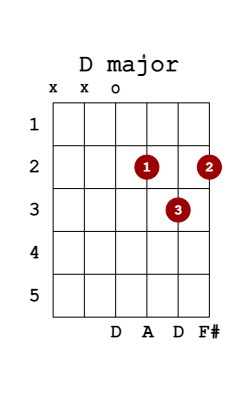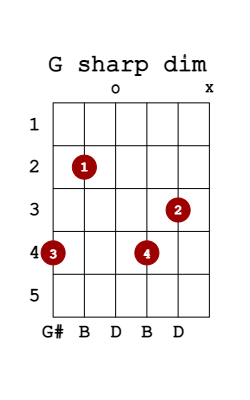As you know, the A major scale has 7 notes, which means that there are 7 chords in the key of A. Each chord roots on a note of the scale.
TIP: The chords of any major key will always have the following major-minor pattern:
I = major, ii = minor, iii = minor, IV = major, V = major, vi = minor, vii = diminished
Popular chord progressions in the key of A
| Progression | Chords |
|---|---|
| I-IV-V | A-D-E |
| I-IV-I-V | A-D-A-E |
| I-V-vi-IV | A-E-F#m-D |
| I-ii-IV-V | A-Bm-D-E |
| I-vi-ii-V | A-F#m-Bm-E |
| I-vi-IV-V | A-F#m-D-E |
Why are these the chords in the key of A major? (the theory)
The chords in A will root on the notes along the A major scale, since all chords in a major key are formed by notes from their respective diatonic scale. Make sure you get familiar with the major scale before continuing this lesson, otherwise you won't really understand much.
The A major scale has 7 notes, each with a corresponding scale degree:
Degree: 1 2 3 4 5 6 7 1(octave)
Note: A B C# D E F# G# A
But how do we know which chord will be major or minor? Starting from a given root note, we need to form its triad in a way which leaves the chord constructed only from notes that can be found on the A major scale.
This means that starting from each root note, we’ll count out the 1st 3rd and 5th degrees along the major scale of that given root note. We than compare these notes with the notes of the A major, and if any single note is not in our key, we’ll have to flatten it to make it a note that can be found on the A major scale. We'll have some examples to explain all of this below.
So let's quickly review the 3 triads we need to use:
- Major triad (major chords) with scale degrees 1 3 5
- Minor triad (minor chords) with scale degrees 1 b3 5
- Diminished triads (diminished chords) with scale degrees 1 b3 b5
Now let’s calculate the quality of each chord in the key of A.
A major
Note: A B C# D E F# G# A
Triad: 1 3 5
This gives us the notes A, C# and E, which is the A major triad, therefore the first chord in the key of A is A major.B minor
Note: B C# D# E F# G# A# B
Triad: 1 3 5
So our 3rd note for would be a D#, but we can’t have that, since that note is not in the key of A major (not on the A major scale). We have to lower the 3rd to the flattened 3rd.
Note: B C# D E F# G# A# B
Triad: 1 b3 5
This gives us the notes B, D and F#, which is the B minor triad. All of these notes are on the A major scale as well, therefore the second chord in the key of A is B minor.C# minor
Note: C# D# E# F# G# A# B# C#
Triad: 1 3 5
So our 3rd note would be a E#, but we can’t have that, since that note is not in the key of A. We have to lower the 3rd to the flattened 3rd.
Note: C# D# E F# G# A# B# C#
Triad: 1 b3 5
This gives us the notes C#, E and G#, which is the C# minor triad, therefore the third chord in the key of A is C# minor.D major
Note: D E F# G A B C# D
Triad: 1 3 5
This time we’re in luck, the 1st, 3rd and 5th of the D major scale are in the key of A, so we don’t need to modify any of the notes. We get the notes D, F# and A, which is the D major triad, therefore the fourth chord in the key of A is D major.E major
Note: E F# G# A B C# D# E
Triad: 1 3 5
Again, the 1st, 3rd and 5th of the E major scale are in the key of A, so we don’t need to modify any of the notes. We get the notes E, G# and B, which is the E major triad, therefore the fifth chord in the key of A is E major.F# minor
Note: F# G# A# B C# D# E# F#
Triad: 1 3 5
Again, we need to modify our 3rd note, which would be a X, since that note is not in the key of A. We have to lower the 3rd to the flattened 3rd.
Note: F# G# A B C# D# E# F#
Triad: 1 b3 5
This gives us the notes F#, A and C#, which is the F# minor triad, therefore the sixth chord in the key of A is F# minor.G# diminished
Note: G# A# B# C# D# E# F## G#
Triad: 1 3 5
Ohoh, now we need to flatten the 3rd AND the 5th, since neither the X or the X are on the A major scale.
Note: G# A# B C# D E# F## G#
Triad: 1 b3 b5
This gives us the notes G#, B and D, which is the G# diminished triad, therefore the seventh chord in the key of A is G# diminished.
And that's about it, you should now know the intricacies of chords in the key of A. The above is of course true not just for guitar chords, but chords in general.
Have a look at guitar chords in other keys as well.








Hi Tom, great explanations and I picked up a few extra pearls!
Cheers!
You’re welcome, great to hear!
This is a great preparation. Well done and thank you very much for sharing.
Thanks very much. For five months, I’ve been trying to to understand how to make code progressions but failing.its after reading this then it worked and now I can find codes of major scales. but how do we with codes of minor scales?
I don’t have this type of info for minor keys on the site yet, but it’s a good idea.
Hi there! This was great, thank you so much! Do you have the same thing for B Major? 😀
Cb = B
Thank you for your sharing. I appreciate your time, your efforts and your concern for love of music. I’m viewing your Guitar chords all the way from Papua new guinea. Our good lord above will guide your life.
Thank you!
If the songs 1 chord is a minor will the 2 and 3 chords be minor or major?
Thanks in advance for your help.
No, it works differently. Minor keys (aeolian mode) start from the 6th note of the Major scale.
Thank you for this… Very helpful. God bless you.